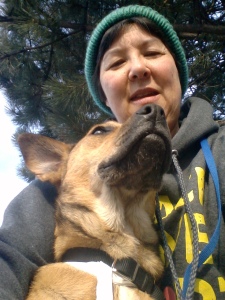So fellow travelers, Janet Rath, the amazing vet tech at the rescue where I volunteer posted this great shot of Bama, a stunning long legged beauty whom so many of us love to walk and play with.
Bama is a wonderful dog with two strikes against her.
She’s black
and she’s big.
Imagine the backlash I would create if I said a child was less adoptable because she was black? or big?
In his talk at a fund raiser for the Nor’Wester Readers Canine Assisted Learning Program this past Sunday, author Jon Katz raised some important issues about dog rescue. I’ve been pondering the thoughts his points raised for me for a few days. Something about this shot of beautiful Bama pulled things together.
In a nutshell Bama is a classic example of why I keep giving my time and energy to dog rescue.
She is homeless through no fault of her own. It is a common myth that dogs end up in shelters because they have behavioral issues. As any professional dog trainer knows a dog’s behavioral issues generally reflect either poor or a lack of training. As Jon was told by a trainer he worked with: “If you want a better dog you have to be a better human.” It is also a fact that behavioral issues are way down on the list of reasons dogs end up in shelters.
She’s smart and has responded well to training. Even the best behaved dog will need extra support when they come into the shelter system because kennel life is stressful. This is especially true for dogs who find themselves in a shelter after living in a home because they have been “surrendered.”
She’s affectionate. It’s another common myth that shelter dogs are a bigger bite risk than dogs acquired from breeders. Yes, knowledgeable, responsible professional breeders can and do breed for temperament, whether that is the kid friendly affability of a lab or the razor sharp focus of a working border collie. Still, even well bred dogs can, will and do bite if scared, attacked or seriously hurt. Being an independent non-profit operation, our rescue has the advantage of being able to choose which dogs are brought into our kennels. This is why Helping Hounds is considered a rescue not a shelter.
She is appreciative of every minute of time and attention she is given. Unlike many of the humans I deal with on a daily basis, (individuals whom I am being paid good taxpayer dollars to assist) the dogs at the rescue are always happy to see me. Even the ones who come in so scared they need to be enticed out of their crates at first are soon wagging their tails and willing to walk or at least snuggle on the couch within a few days. These dogs take in everything I have to offer, every single time I show up.
She is safe now. If Helping Hounds had not opted to take Bama granting her a slot on the North bound transport last month, she would no longer be walking this earth with those long graceful legs. Her boundless spirit and energy would have been extinguished simply because her “time was up.” That “time” can be a brief as a week or as long as a month and when that time comes, the dog is killed regardless of temperament, health or age.
Which is why adopting a shelter dog is often referred to as “rescue,” to address one observation Jon made in his talk. It is I think worth noting the families who send in updates almost always refer to their dogs as “adopted,” after all the contract says “adoption.” The current trend of using the term rescue/rescue dog draws attention to the larger social issue of the high kill rate at too many shelters. It’s an issue the word “adoption” demurely sidestepped for decades because no one wanted to admit the high number of animals being killed at shelters. (The entire “no-kill” concept is a topic requiring it’s own post)
Let me be clear. I am not one of those who believe everyone who wants a dog has a morale obligation to adopt a rescue dog. That’s a point where some of my rescue friends and I part ways and I am fine with that point of departure. I agree with Jon’s thoughtful process of considering all the aspects of how an animal fits into one’s life. There is a valid calling for knowledgeable, responsible professional breeders, none of whom would ever sell their dogs to petstores or to people sight unseen over the internet or through craigslist.
If the rescue community is going to achieve their goals of making a difference in the long term, we do need to address the larger social issues such as spay/neuter, breeder licensing, breed discrimination and the criminal element of systemic abuse. Most rescues, like the operation I am part of have their hands full just trying to find good homes for the many sweet souls who come through their doors.
Souls like sweet sweet Bama.
Walk gently on the path my friends and may adventure find you ready.
Editorial Note: Sunday’s at the Rescue is a series of posts about my experiences working with rescue dogs. It is named for Sunday, a sweet young dog who came through the rescue where I volunteer, stole a piece of my heart (as so many of them do) and got herself adopted into a great home.
As for Miss Bama, we are happy to update our post with the news she was adopted April 3rd by a wonderful family who are looking forward to running and playing with her for years to come.





































